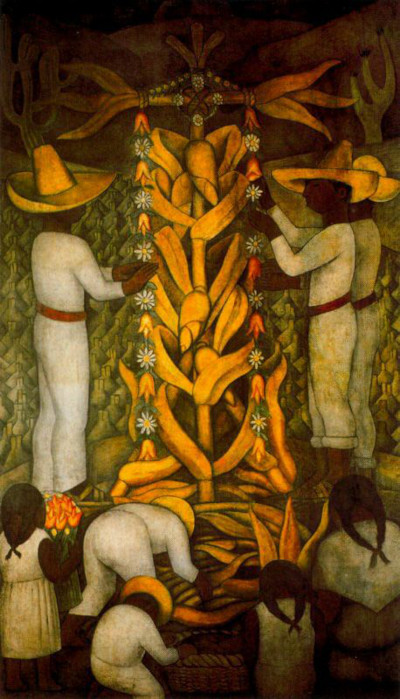The Maize Festival was completed by Diego Rivera over the period of 1923-1924. It can today be found in the Secretariat of Public Education Main Headquarters, Mexico City, Mexico.
The mural features a local community hard at work, creating a display for this festival. Children are found at the foot of the painting performing some of the simpler tasks whilst adults carefully arrange different natural elements to create a beautiful display that would be fitting for the upcoming celebrations. Rivera would focus on festival life many times within his oeuvre and considered it a key part of life for those in the poorer sectors of society. Most would not have leisure or holiday time to enjoy, and so festivals such as this would give them something to look forward to and a break from the hard toil of their daily lives. Flowers would often play an important part in their celebrations, but this particular event was based on Maize, which itself was a common source of income for the farm workers and so represented an important part of their lives. Other examples of Rivera's work on this topic included Woman with Flowers, Flower Festival Feast of Santa Anita and Flower Festival.
The workers would busily put this display together in the hot sun, and would mostly wear wide hats that could protect them from the sun whilst outside at work. We find an elaborate set of flowers which would be arranged in a floral pattern around other plants which brought a variety of colour and form. All of the clothing worn here is white, from the pretty dresses worn by the young girls, to the smart long shirts and trousers on the men at the back of the painting. Each male also has a red belt across their midrift and the consistency of these outfits suggests perhaps that they are already wearing their clothing for the festival, and so are perhaps just perfecting the final touches of this arrangement. Rivera knew these cultures well and would spend time within them in order to understand their way of life as well as he could. One of his stylistic tendencies within these types of paintings was to leave out facial expressions, making each figure fairly anonymous.
Social Realism was the term given to many of this artist's paintings which promoted the culture of Mexico to the rest of the world. He would take in influences from Europe during his time living there and then returned home to apply these ideas to content specific to his own nation. He spent considerable time in France but also travelled to other nations in search of ideas for his work, be it from other artists or from experiencing elements from other cultures, such as food, fashion and so on. He would never lose his strong connection to his native people, though, and so was eventually rewarded with a number of prestigious mural commissions across Mexico with a socialist but patriotic slant. Many of these murals still reside within the same locations today and can be visited by the public.




